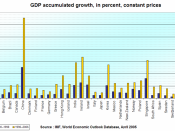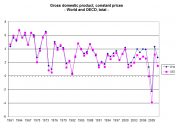OverviewJapan experienced consistent economic expansion in the post-war period, fuelled by a strong export market and the rapid development of key industries. Growth was supported in the following decades by healthy domestic demand and funded mainly through bank loans using land and financial assets as collateral. In the 1990s, when asset prices began to decline, growth stalled to an average of about 1% a year. Since then, the economy has been characterized by a floundering financial sector and a downturn in domestic consumption related to high unemployment, competition from lower-priced imports, and declining wages. In recent years, the country's once strong export trade has been eroded by both a regional and a US-led recession, compounded by a rise in imports. In 2001, Japan's trade surplus suffered its biggest decline since 1970, falling by 33% from 2000 to ÃÂ¥8.5 trillion.
To stimulate the economy, the government provided some US$1 trillion in a series of fiscal injections throughout the 1990s, producing modest GDP growth averaging 1.2%
per annum over the decade. The resulting budget deficit has remained consistently high and reducing it is a leading government priority. Plans for comprehensive structural reforms in all areas of the economy are in place, but proceeding slowly. Corporate restructuring has led to increased unemployment, which reached a record high of 5% at the end of 2001. Deregulation has supported increasing foreign direct investment in recent years, which reached more than US$25 billion in 2001, four times its 1997 level. Efforts have been made to revitalize business and attract new entrants to areas such as communications, finance, transportation and retailing. Although manufacturing remains the backbone of the economy, accounting for 25% of GDP, service industries have rapidly grown in importance. Measures were introduced in mid-2001 to eliminate an estimated ÃÂ¥30 trillion in bad debts in the...


